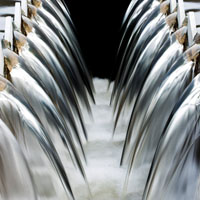In a new study released by the Department of Energy’s Pacific Northwest National Laboratory (NPPL), algal fuels could replace 17 percent of the United States’ imported oil by 2020. The paper was published in the journal of Water Resources Research but warned that biofuels production, including algal fuels, can require a lot of water so the study cautioned that being smart about where the algae is grown can reduce the water needed. Researchers concluded that water use could be drastically reduced if the algae is grown in the sunniest and most humid climates including the Gulf Coast, the Southeastern Seaboard and the Great Lakes.
 “Algae has been a hot topic of biofuel discussions recently, but no one has taken such a detailed look at how much America could make – and how much water and land it would require — until now,” said Mark Wigmosta, lead author and a PNNL hydrologist. “This research provides the groundwork and initial estimates needed to better inform renewable energy decisions.”
“Algae has been a hot topic of biofuel discussions recently, but no one has taken such a detailed look at how much America could make – and how much water and land it would require — until now,” said Mark Wigmosta, lead author and a PNNL hydrologist. “This research provides the groundwork and initial estimates needed to better inform renewable energy decisions.”
The research team’s goal was to provide the first in-depth assessment of algal biofuels potential based on the amount of available land and water. The study also factored in how much water would need to be replaced due to evaporation over 30 years. The research analyzed previously published data to determine how much algae could be grown in outdoor, fresh water ponds when using current technologies. The study did not factor in algae grown in salt water and covered ponds.
When taking into account various factors, the research team determined that 21 billion gallons of algal oil, the amount equal to the advanced biofuels category of the Renewable Fuels Standard (RFS2), could be produced by algae by 2022.
The researchers found that 21 billion gallons of algal oil, equal to the 2022 advanced biofuels goal set out by the Energy Independence and Security Act, can be produced from American-grown algae. This amount equates to 17 percent of the oil that the U.S. imported in 2008 for transportation fuels. To achieve this amount, the researchers estimate that the amount of land needed to produce this number would be approximately the size of the state of South Carolina. They also found that it would take 350 gallons of water per gallon of oil — or a quarter of what the country currently uses for irrigated agriculture — to produce 21 billion gallons of algal biofuel.
The study also concluded that up to 48 percent of the current transportation oil imports could be replaced with algae, but this higher production level would require significantly more water and land. Therefore the authors focused their research on the U.S. regions that would use less water to grow algae.
The authors also found that algae’s water use is similar to other biofuel sources. When considering the gas efficiency of a standard light-utility vehicle, they estimated growing algae uses anywhere between 8.6 and 50.2 gallons of water per mile driven on algal biofuel. In comparison, data from previously published research indicated that corn ethanol  can be made with less water, but showed a larger usage range: between 0.6 and 61.9 gallons of water per mile driven. The ranges significantly varied due to several factors including the differing water needs of specific growing regions (aka irrigated versus non-irrigated crops) and the different assumptions and methods used by various researchers. Previously published data indicated conventional gas uses between about 0.09 and 0.3 gallons of water per mile.
can be made with less water, but showed a larger usage range: between 0.6 and 61.9 gallons of water per mile driven. The ranges significantly varied due to several factors including the differing water needs of specific growing regions (aka irrigated versus non-irrigated crops) and the different assumptions and methods used by various researchers. Previously published data indicated conventional gas uses between about 0.09 and 0.3 gallons of water per mile.
The authors deduced that algae has several advantages over other biofuel sources. They note that algae can produce more than 80 times more oil than corn per hectare a year and like corn and soybeans, don’t compete for food. In addition, the authors note that algae are carbon dioxide-consuming organisms, so they are considered a carbon-neutral energy source. Algae can feed off carbon emissions from power plants or other biorefineries, delaying the emissions’ entry into the atmosphere. Algae also digest nitrogen and phosphorous, which are common water pollutants. That means algae can also grow in — and clean — municipal waste water.
“Water is an important consideration when choosing a biofuel source,” Wigmosta said. “And so are many other factors. Algae could be part of the solution to the nation’s energy puzzle — if we’re smart about where we place growth ponds and the technical challenges to achieving commercial-scale algal biofuel production are met.”

